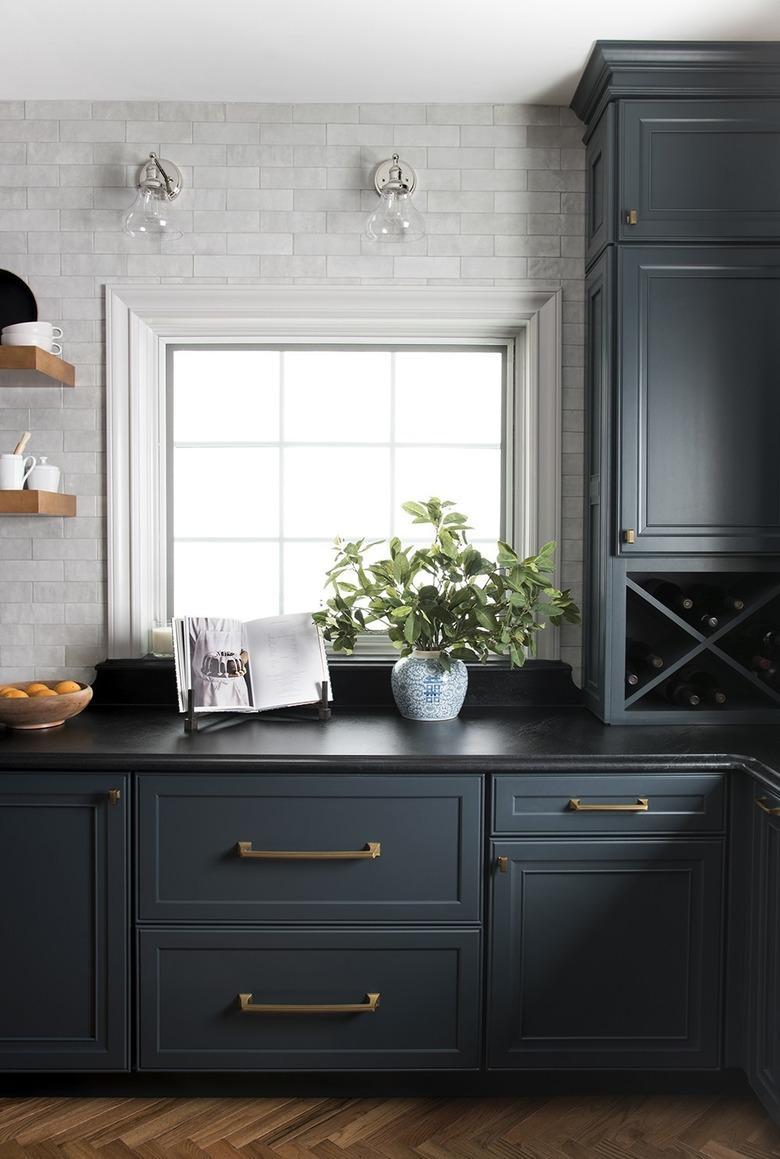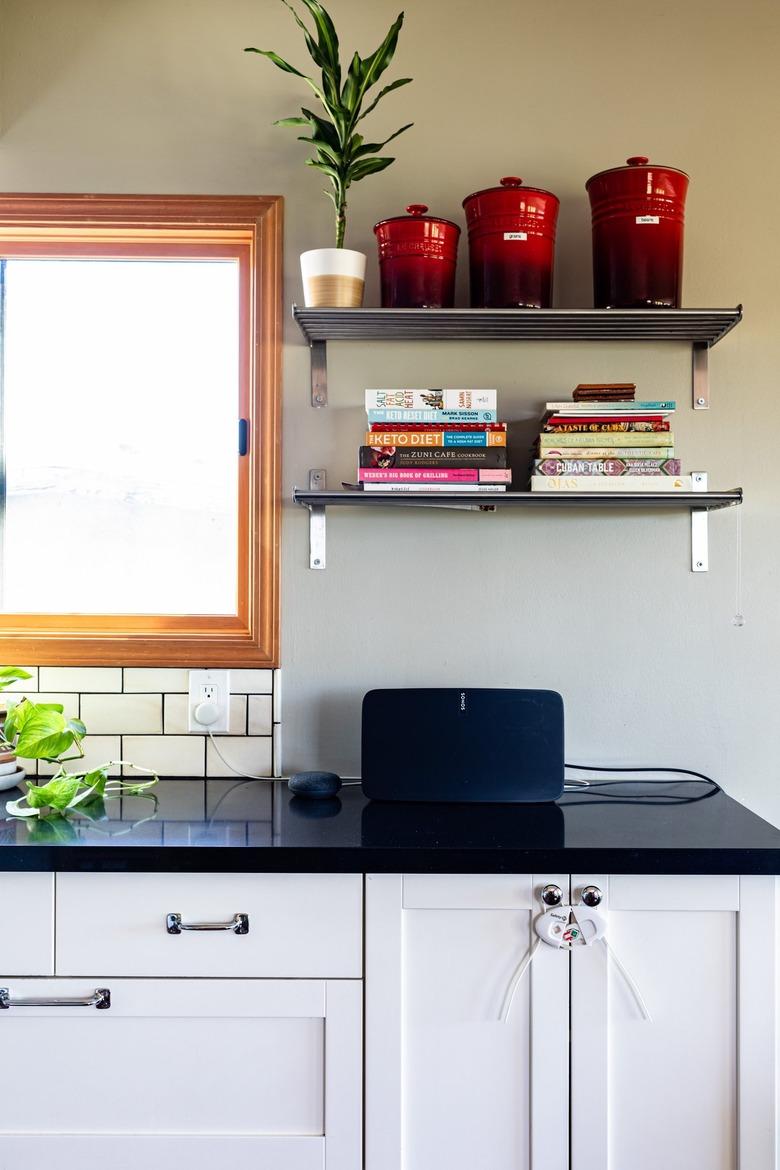Soapstone Vs. Granite Countertops: Pros And Cons Explained
While granite has been considered one of the "go-to" countertop materials, soapstone is making a comeback as a viable alternative. It can be difficult to choose between the two — although they are very different in color and texture, both yield the warmth and beauty of natural stone. You should know that no matter what type of stone kitchen countertop you go with for your remodel, it'll likely be a fairly large expense.
According to HomeAdvisor, as of 2021 the typical price range for granite countertops is $2,000 to $4,500 — the stone slabs cost $40 to $60 per square foot. For soapstone, the website reports a slightly higher price point, with a range of $2,700 to $4,200 and soapstone slabs coming in at $50 to $100 per square foot. The cost of soapstone is comparable to the price of marble countertops, which HomeAdvisor has priced at $40 to $100 per square foot.
So which one is better? Let's take a closer look.
Appearance
Soapstone
Soapstone is a metamorphic rock composed of talc and other minerals. It got its name because it feels like soap. While it does not have the dramatic dark mineral grains of granite, it does have variegated veining. And colors tend to include shades of gray, blue, green, or brown.
Granite, an igneous stone composed of quartz and feldspar, is one of the hardest materials on Earth — which is one reason it's so popular for kitchen counters. Then there is its natural beauty. Patterns can be made up of small, dense mottling or large swirls of multicolored red, pink, gray, brown, and white in varied combinations. One nice thing is that when you purchase granite, you can pick the specific slab, so you know exactly what you are getting.
Types
Soapstone
When it comes to soapstone, there are two main categories: artistic and architectural. Artistic soapstone is soft and made up of 75 percent talc — it's oftentimes used for carving sculptural pieces, as its name implies. Architectural soapstone, on the other hand, has less talc at 60 to 75 percent and is used for countertops.
Meanwhile, there are many different types of granite. For instance, you may not be aware that quartz countertops are a type of granite. There are six main categories, which include Amphibole (green or black), Biotite (brown or black), Potassium Feldspar (pink), Muscovite (gold or yellow), Feldspar (off-white), and Quartz (milky white). All of these categories have many sub-categories as well.
Maintenance
Soapstone
All stone countertops will require some form of maintenance, but here's the good news: Soapstone is generally low maintenance when compared to granite.
After you install soapstone countertops, rub the material with mineral oil to accent the stone's striking veining. Also, soapstone is widely used for masonry, heaters, and countertops in forensic and science labs since it's highly resistant to chemicals, so you'll be pleased to know that you don't have to seal it.
Being softer than synthetic products, granite however, must be sealed with a water- or oil-based sealant after installation and then once or twice a year to maintain their sheen and resist staining. You can purchase good commercial granite and marble sealants from home supply stores or tile and stone retailers. Before sealing the stone, wipe it with a clean, damp cloth and let it dry, so you don't seal in dust or food particles. Apply a thin layer of the sealant with a sponge or paint roller across the stone. Let it sit for about five minutes, then wipe with another clean, dry cloth. Allow the countertop to dry for 24 hours before using it.
After you set soapstone in place, you should rub it with mineral oil to accent the stone's striking marbling. Also, soapstone is widely used for masonry, heaters, and countertops in forensic and science labs since it's highly resistant to chemicals, so you'll be pleased to know that you don't have to seal it.
Durability
Soapstone
Even though it doesn't have to be sealed, one of the cons of soapstone is that it's prone to scratches, since it's soft. Sanding and treating it with mineral oil and fine-grit sandpaper will replace its sheen, but a professional must perform the process.
This is where granite wins out. Granite is widely considered to be a very durable material and won't show scratches as easily as soapstone.
Resistance
Soapstone
A soapstone countertop is more resistant to stains and chemicals than granite is. It is unaffected by acids and alkalis, so tomato juice, wine, and vinegar will not discolor the stone. Also, you can put a hot pot on soapstone and it won't damage the surface.
Granite is famed for its heat-resistant abilities, but it's still a porous stone, which means there can be staining if you leave puddles of colored liquid and food on your countertops — you'll need to be vigilant about clean-up. Just know that your granite counters won't stain immediately, making it fairly resistant to marks and scuffs.
The Final Choice: Soapstone vs. Granite
It's tricky to answer the "Is soapstone better than granite?" question because each material shines in its own right. Let's recap the details:
- Both granite and soapstone have natural beauty,
but you will be able to hand-pick the granite slab for your countertop. - Granite countertops cost less than soapstone
countertops, so that's something to keep in mind if you're sticking to a
budget. - Granite requires more regular maintenance than
soapstone. - Soapstone is more prone to scratches than
granite. - Soapstone is more resistant to stains than
granite.
Since both materials have their own unique set of pros and cons, it's really up to you and what you value in your cook space. Granite and soapstone each carry different levels of care and maintenance, but one thing's for sure: Both materials will be visually striking in any kitchen design.


